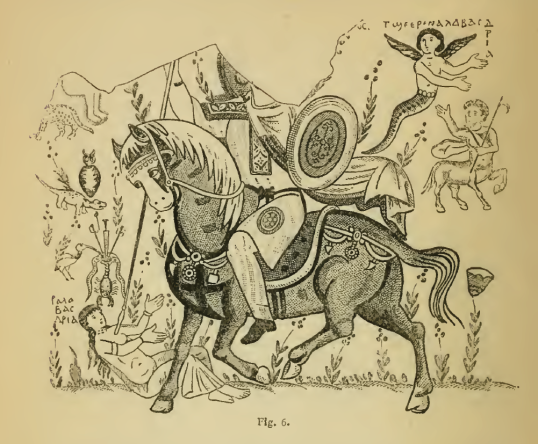Thēsauròs Zōēs | Life’s Treasure
The proper name simat hiia is conventionally translated as “Treasure of Life,” the word simta being compared fruitfully with the word symh “treasure” in other Aramaic languages, and the whole phrase being compared with the Manichaean thēsauròs zōēs, which means much the same thing in Greek. Both the Aramaic words are conventionally derived from the root s-w-m, one of the more common roots meaning “to put” or “place.”
In the Book of John (chapter 58), she appears with her male counterpart, sam hiia.
A treasure am I—Life’s Treasure (simat hiia)! / Life’s Treasure (sam hiia), in [Life’s] radiant tartour, / sent me to the adamantine worlds.
The male member of the pair boasts a tartour (Mandaic ṭarṭabuna, Arabic طرطور, allegedly from Latin turritus “turreted, tower-like”). In the medieval Levant, these caps were worn primarily by married noblewomen, a fashion that apparently reached Europe via the Crusaders (where the tartour became the model for the stereotypical conical “princess’s cap”), but elsewhere in the Middle East they served as unisex headgear (and are still worn today by dervishes of certain orders). Both sam and simat are popular Mandaean names, even to this day. It would appear that sam is merely another word from the same root, although Drower and Macuch translate it as “He-Placed.” The semantic progression from “placed” to “treasure” is not clear. Could there be another explanation for this word?
Five months ago, I drafted an article on Greek loanwords in Mandaic and offered it as a session on Academia.edu. One of the observations I made was that Greek η ē regularly corresponds not to the expected high vowel aksa (i) in Mandaic, but rather the letter halqa (a):
šaraia ‘silk,’ Gk. sērikós
sasa ‘moth,’ Gk. sēs
kaluza ‘voice,’ Gk. kēruks
To add to this list of mysteries is the Greek word kibōtós ‘coffin,’ which appears in this same text as qabut. An obvious cognate is Syriac qēʾḇūṯā. In fact, there is a consistent pattern of Mandaic halqa corresponding to the sequence e(ʾ) in Syriac:
haria ‘nobles,’ cf. Syr heʾre
kauila ‘ark,’ cf. Syr keʾwelā
makulta ‘food,’ cf. Syr meʾḵolṯā
qaba ‘muzzle,’ cf. Syr qeʾmā
šaraia ‘silk,’ cf. Syr šeʾrāyā
zaba ‘wolf,’ cf. Syr diʾḇā
The last word is also regularly spelled diba in Mandaic, reflecting an intriguing feature of the so-called “classical” orthography: by-forms in which a historicizing (or pseudo-historical) spelling like zaba *ðiʾb- coëxists with a phonemic one like diba, which reflects both the merger of PS *ð and *d, and the loss of the word-internal glottal stop.
At one point, I was a bit of a purist when it came to halqa; I insisted then that it always consistently represented a vowel, and never a glottal stop, but in light of this evidence I am forced to modify my position. There are obvious cases, such as the words above, in which halqa represents not a vowel but rather a glottal stop. To distinguish these words from those written according to a phonemic orthography, I am writing them in small caps in my forthcoming grammar, adopting a convention used for other languages of the region. Nearly all of these words appear at some point or another in the Book of John.
Is there, then, a Syriac cognate to sam, along the lines of sīmṯā? As it happens, yes, we are in luck. The Syriac word seʾmā “silver,” a loanword from Greek ἄσημον ásēmon, is used to distinguish the metal, “silver,” from the old Semitic word kaspā, which is metaphorically extended to mean “money” in most cases. Thus Syriac seʾm and sīmṯā correspond quite nicely to Mandaic sama and simta, and would represent yet another potential Greek loan to add to the list of words that I have compiled.


